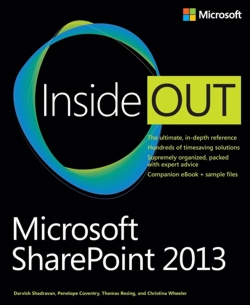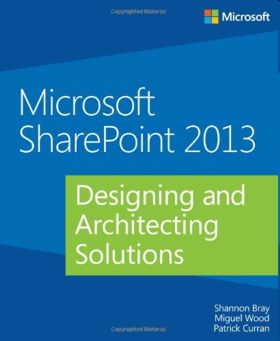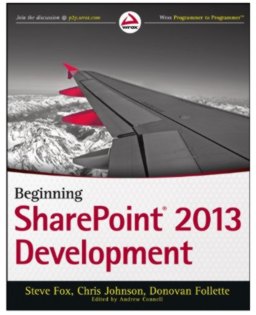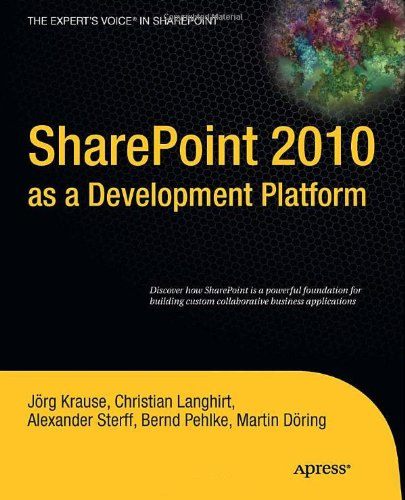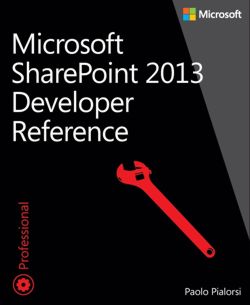| SharePoint Book Choice |
| Written by Kay Ewbank | |||
| Thursday, 23 January 2014 | |||
Page 1 of 2 SharePoint continues to grow in importance and popularity, and more developers need to learn how to work with it. One difficulty with this is having to learn the SharePoint infrastructure as the first step, as this is by no means trivial, and changes between the different versions. To make this selection of books to help you, we’ve looked through the best of those we’ve reviewed for both SharePoint 2010 and 2013. When it comes to books, I Programmer's mission is to provide unbiased reviews that you can trust - and they are written by those who use and understand the technologies concerned. Although we can only cover a fraction of the new programming books published, we try to include those that seem important and topical and this means we end up reading some that are dull and boring and even find some that are capable of misleading and confusing the reader. For Programmer's Bookshelf, however, we pick only ones that we can recommend, with a range to suit developers with different interests and at different levels of expertise.
If you want to read more of the original review click in the link in each title. Clicking on the book jacket in the side panel will take you to Amazon. If you just want to find out more about the book click in the top portion of the thumbnail to open the book's product details page. If you do decide to make a book purchase accessing Amazon from a link on I Programmer means that we are credited with a few cents - so thanks to all of you who support us in this way.
Beginners start hereIf you need a general introduction to SharePoint 2013, Microsoft SharePoint 2013 Inside Out provides good coverage of SharePoint, though the material stops short of full developer topics
The book, published by Microsoft Press, starts from a general intro before moving on to administration for business users, list and library apps. Team sites are also covered, as is how Office applications are used with SharePoint. Using workflows for automation and creating and editing custom workflows using SharePoint Designer also receive coverage, as do web parts and web content management sites. Business intelligence in SharePoint is well described, with chapters on Excel Services, Performance Point Services, and Visio Services. SharePoint Search also receives some good coverage, and the book closes with an introduction to custom development with SharePoint 2013. There are high level introductions to the different APIs, and a short walkthrough of creating a simple app using Napa. Overall, the book works well for end users who don’t know SharePoint and want to get a good overview of what it does and what’s possible. SharePoint on the large scaleIn the case of Microsoft SharePoint 2013 Designing and Architecting Solutions, also from Microsoft Press, the audience is the IT professional who knows SharePoint, but needs to get to grips with SharePoint 2013 and how to make it all work. It also has useful material if you know SharePoint 2010, and need to move to SharePoint 2013.
Much of the book is written on the assumption you’re putting together a SharePoint ‘farm’ with multiple SharePoint and/or SQL servers working together to provide a set of SharePoint services for a specific site. There are introductions to the SharePoint 2013 architecture, PowerShell and SharePoint cmdlets, and how to gather the requirements for your system. The central section of the book looks at design considerations for SharePoint 2013, how to design your system’s storage, and optimizing SQL Server for SharePoint, platform security, authentication and authorization. There’s a good chapter on upgrading your SharePoint 2010 environment, with suggestions on how to work out the current structure and how to clean up and document the various elements before testing, implementing and validating the upgrade. The final part of the book looks at concepts for infrastructure reliability. If you need to put a SharePoint 2013 farm into production, it would be a good book to have by your side and we gave it a rating of 4. SharePoint for developersBeginning SharePoint 2013 Development, published by Wrox, is aimed at experienced developers who want to learn SharePoint. Our analysis was that it’s well written, code heavy, and has nice touches suggestions for recommended reading (mainly MSDN articles) at the end of each chapter.
The book starts with an introduction to SharePoint, the platform and the administration facilities. The authors then look at the SharePoint apps model, how SharePoint fits with apps for Office, and the three deployment models for SharePoint – SharePoint hosted, auto-hosted and provider hosted. There’s coverage of the different developer tools you can use – SharePoint Designer, Napa (Microsoft’s lightweight browser-based tool for SharePoint development), Visual Studio, Expression Blend and Fiddler. Part 2 of shows how you can package and deploy your apps and how they can be distributed. The final part of the book covers advanced developer topics - developing integrated apps for Office and SharePoint; remote event receivers in SharePoint, and SharePoint’s Business Connectivity Services. SharePoint 2010 as a Development Platform from Apress provides comprehensive coverage of developer topics with no time wasted on unnecessary basics, and as such we can recommend it to competent programmers who needs to develop in SharePoint. Giving it a rating of 4.5 we consider it not perfect, but a good addition to your shelves.
This is a book is intended for advanced web developers, and the assumption is that you already have knowledge of HTML, CSS and JavaScript; Visual Studio, C#, ASP.NET, XML and how to use databases. The book starts with chapters on SharePoint’s object model, accessing the API, templates, web parts, and application techniques, while part Two of the book covers the user interface, showing how to use Web controls, program the client model, integrate Silverlight, and use charts and maps. The final part of the book looks at advanced techniques with chapters on form services and InfoPath, and Workflows. Bob German and Paul Stubbs, the authors of SharePoint 2010 Development with Silverlight, and publishers Addison-Wesley can justifiably feel a bit miffed that Microsoft has stopped Silverlight development, but this is a book that could still be useful if you need to maintain or rework Silverlight custom web parts.
The book, which we rated 4.5, has some useful material on developing Web parts, expression blend for use with XAML, data binding, and using the HTML bridge. There are chapters on Silverlight navigation and using Silverlight with SharePoint Online for cloud apps. The material is well written and readable, and there’s plenty of well explained code. The descriptions of working with SharePoint’s Javascript with JQuery API is very good, as are the descriptions of working with REST and Azure. Microsoft SharePoint 2013 Developer Reference from Microsoft Press was awarded a rating of 4 our of 5. By Paolo Pialorsi, it is aimed at .NET developers wanting to understand SharePoint, and the author takes you from a quick overview of SharePoint 2013 and its data foundations through developing SharePoint apps, extending SharePoint and developing workflows.
This is a hefty book with a lot of code, covering everything from developing for the client side using the SharePoint Client Object Model and SOAP services, through using the REST (Representational State Transfer) APIs introduced with SharePoint 2013, to extending SharePoint with Web Parts and custom pages. <ASIN:0735666997> <ASIN:0735671680> <ASIN:1118495845> <ASIN:1430227060> <ASIN:0321769597> <ASIN:0735670714>
|
|||
| Last Updated ( Thursday, 23 January 2014 ) |

